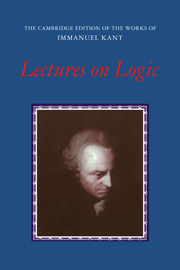Book contents
- Frontmatter
- Contents
- General editors' preface
- Acknowledgments
- Translator's introduction
- PART I The Blomberg logic
- PART II
- PART III The Dohna-Wundlacken logic
- Prolegomena
- Tractatio ipsa
- The doctrine of elements
- Doctrine of method
- PART IV The Jäsche logic
- PART V Appendixes
- Explanatory notes
- Name index
- Subject index
The doctrine of elements
Published online by Cambridge University Press: 05 June 2012
- Frontmatter
- Contents
- General editors' preface
- Acknowledgments
- Translator's introduction
- PART I The Blomberg logic
- PART II
- PART III The Dohna-Wundlacken logic
- Prolegomena
- Tractatio ipsa
- The doctrine of elements
- Doctrine of method
- PART IV The Jäsche logic
- PART V Appendixes
- Explanatory notes
- Name index
- Subject index
Summary
{It treats the concepts of the understanding in general. The division of all thought – which has various forms that may be exhausted and brought into a system. The general thing that lies at the basis of all cognition is representation – a fundamental concept that cannot be explained. Cognition is relation of representation to an object – combined with an actio in the mind – consciousness (representation of our representation), which is lacking in obscure representations.}
The ancients divided it into (1.) apprehensio simplex, (2.) judicium, and (3.) ratiocinium. Our cognition involves two things, intuition and concept. Representations can also be related to something other than cognition, namely, to the feeling of pleasure and displeasure (the way in which we are affected by things). All our intuition belongs to sensibility, every concept to the understanding. Sensibility contains two faculties, sense and imagination {this is the magical power of the human spirit}, or the faculty for intuition of an object insofar as it is not present[;] but sense is that faculty insofar as the object is present.
{All our representation is (1.) sensation – its relation to the subject, (2.) cognition – relation to the object. (1.) e.g., pleasure – lies merely in me – not in the object.}
- Type
- Chapter
- Information
- Lectures on Logic , pp. 440 - 510Publisher: Cambridge University PressPrint publication year: 1992

